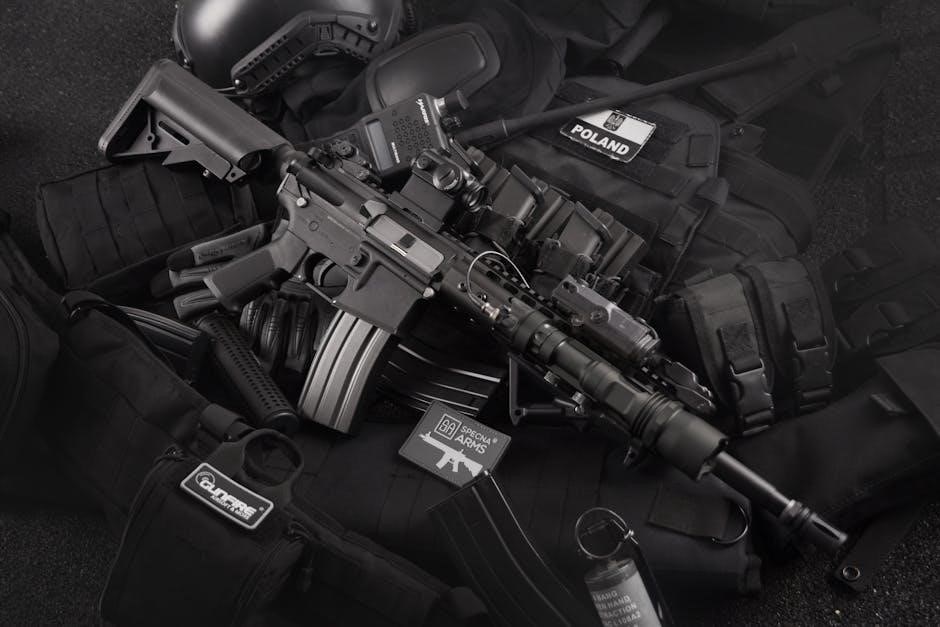The Salvation Army Valuation Guide empowers donors to understand the value of their contributions, ensuring transparency and fairness in charitable giving.

What is the Salvation Army Valuation Guide?
The Salvation Army Valuation Guide is a resource providing estimated values for donated items, helping donors assess fair market value for tax-deductible contributions accurately.
Definition and Purpose
The Salvation Army Valuation Guide is a comprehensive resource designed to help donors determine the fair market value of their contributions. Its primary purpose is to provide transparency and consistency in valuing donated items, ensuring donors can accurately assess their contributions for tax-deductible purposes. By establishing a clear framework, the guide helps individuals understand the value of their donations, from clothing and household goods to furniture and other tangible items. This tool is essential for both donors and recipients, as it promotes fairness and accountability in charitable giving. The guide aligns with the Salvation Army’s mission to support communities in need while empowering donors to make informed decisions about their contributions.
How it Helps Donors and Recipients

The Salvation Army Valuation Guide serves as a vital tool for both donors and recipients, fostering a mutually beneficial relationship. For donors, it provides a clear and standardized method to determine the value of their contributions, simplifying the process of claiming tax deductions. This transparency ensures that donors feel confident in the fairness of their assessments. On the recipient side, the guide helps the Salvation Army allocate resources effectively, ensuring that donations are used efficiently to support community programs and services. By bridging the gap between donors and those in need, the guide enhances the overall impact of charitable giving, making it easier for individuals to contribute meaningfully while supporting the organization’s mission to serve humanity.

Understanding the Salvation Army Donation Value Guide
The Salvation Army Donation Value Guide provides donors with approximate values for commonly donated items, ensuring transparency and helping both donors and the organization maximize the impact of charitable giving.
Determining Fair Market Value
Determining the fair market value of donated items is crucial for accurate tax deductions and ensuring transparency in charitable giving. The Salvation Army provides a valuation guide to help donors estimate the value of their contributions. Fair market value is defined as the price an item would sell for in its current condition on the open market. Donors can use the guide to assess items like clothing, furniture, and household goods. For high-value items, such as art or jewelry, professional appraisals may be necessary. The guide also offers categories and price ranges to simplify the process. By accurately determining fair market value, donors ensure their contributions are properly acknowledged and their tax deductions are valid. This step is essential for both donors and the organization to maintain trust and compliance with tax regulations.
Categories of Donated Items
The Salvation Army Valuation Guide categorizes donated items to simplify the valuation process for donors. Common categories include clothing, furniture, household goods, books, and electronics. Clothing items are further divided into men’s, women’s, and children’s categories, with specific values assigned based on condition. Furniture is categorized by type, such as chairs, tables, or sofas, and valuation depends on quality and usability. Household goods include kitchenware, linens, and small appliances, with values reflecting their functional condition. Books are categorized by type, such as hardcover, paperback, or children’s books, and valued based on their condition and demand. Electronics, like TVs or computers, are valued based on age and functionality. These categories help donors accurately assess their contributions, ensuring fair and consistent valuations for tax purposes.

How the Salvation Army Uses Donations
The Salvation Army uses donations to fund specific programs, provide disaster relief, support rehabilitation services, and assist underserved communities, ensuring resources directly benefit those in need.
Funding Specific Programs
The Salvation Army uses donations to fund vital programs that address poverty, homelessness, and disaster relief. Donations support feeding the hungry, sheltering the homeless, and providing disaster relief services. They also fund rehabilitation programs for individuals struggling with addiction and offer youth development services. By allocating resources to these initiatives, The Salvation Army ensures that donations directly impact communities in need. These programs are designed to uplift individuals and families, offering hope and practical assistance. The organization’s commitment to transparency ensures that every contribution is used effectively to make a meaningful difference. Funding these specific programs allows The Salvation Army to continue its mission of serving humanity and transforming lives. Donors can trust that their support is instrumental in driving positive change.
Allocating Resources to Communities
The Salvation Army prioritizes allocating resources to communities in need, ensuring that donations directly benefit local populations. By assessing community-specific requirements, the organization efficiently distributes funds to address poverty, homelessness, and disaster relief. Donations support initiatives such as food distribution, shelter services, and rehabilitation programs. The Salvation Army operates globally, serving over 130 countries, and tailors its resource allocation to meet the unique challenges of each region. This approach ensures that aid reaches those who need it most, fostering hope and resilience. Through transparent and efficient resource management, the organization maximizes the impact of every contribution, making a tangible difference in communities worldwide. This commitment to local-focused allocation underscores The Salvation Army’s mission to serve humanity and uplift those in distress.
Impact on Local and Global Missions
The Salvation Army’s valuation guide plays a pivotal role in amplifying the impact of donations on both local and global missions. By providing a clear framework for valuing contributions, the guide ensures that resources are maximized to support critical initiatives. Locally, donations fund programs such as food distribution, disaster relief, and rehabilitation services, directly improving community well-being. Globally, these contributions enable The Salvation Army to operate in over 130 countries, addressing widespread challenges like poverty, homelessness, and humanitarian crises. The guide’s transparency and fairness inspire trust, encouraging more people to donate and support the organization’s mission to preach the gospel and serve humanity. This dual focus on local and global impact underscores The Salvation Army’s commitment to making a difference wherever need exists.

Salvation Army Tax Benefits for Donations
The Salvation Army offers tax-deductible benefits for donations, with their valuation guide helping donors determine item values for accurate tax deductions, supporting their charitable mission.
Tax-Deductible Values of Donations
The Salvation Army Valuation Guide provides donors with a clear understanding of the tax-deductible values for their contributions. By referencing the guide, individuals can determine the approximate fair market value of commonly donated items, such as clothing, furniture, and household goods. This ensures accurate reporting for tax purposes. The IRS requires documentation for deductions, and the guide helps donors meet these requirements. Values are based on the item’s condition and average resale price. For high-value items, appraisals may be necessary. Donors should retain receipts and records of their contributions. The guide simplifies the process, making it easier to claim deductions while supporting The Salvation Army’s mission. Understanding these values helps donors maximize their tax benefits while contributing to a charitable cause.
Itemizing Deductions for Donated Goods
Itemizing deductions for donated goods is a crucial step for maximizing tax benefits when supporting The Salvation Army. The valuation guide helps donors accurately list the fair market value of each item, ensuring compliance with IRS requirements. Donors must document the condition and value of donated goods, with the guide providing a clear framework for categorizing items like clothing, furniture, and household goods. For larger donations, detailed receipts and appraisals may be necessary. The Salvation Army issues receipts for donations, which donors can use when filing taxes. Accurate itemization ensures donors receive the proper tax credit while contributing to a meaningful cause. Proper documentation and adherence to IRS guidelines are essential for a seamless process. This approach benefits both donors and the communities served by The Salvation Army.
Record-Keeping Tips for Tax Purposes
Proper record-keeping is essential for tax purposes when donating to The Salvation Army. Donors should obtain and keep receipts for all contributions, noting the date, location, and items donated. For items valued over $250, a written acknowledgment from The Salvation Army is required. Detailed documentation, including photos or lists of donated goods, can help verify the value of contributions. Donors should also retain appraisals for high-value items, such as furniture or electronics. Organizing these records in a dedicated file ensures easy access during tax filing. The Salvation Army Valuation Guide provides a framework to simplify this process, helping donors maintain accurate and compliant records. Proper documentation not only aids in tax deductions but also supports the transparency of charitable giving.

Finding a Salvation Army Location Near You
Visit The Salvation Army’s official website and use their location finder tool by entering your zip code to discover nearby donation centers and stores efficiently.

Using Online Tools to Locate Centers
The Salvation Army provides convenient online tools to help donors locate nearby centers quickly. Their official website features a location finder tool where you can enter your zip code to find the closest donation centers and stores. Additionally, mobile apps and online directories offer real-time updates, ensuring you can easily discover where to donate. These tools often include interactive maps, driving directions, and lists of accepted items, making the process seamless. By utilizing these resources, donors can efficiently find drop-off points, thrift stores, or community centers. This accessibility ensures that your contributions reach those in need promptly. The Salvation Army’s online tools simplify the process of giving, allowing you to make a meaningful impact without hassle.
Preparing and Transporting Donations
Properly preparing and transporting donations ensures they reach their destination in good condition. Start by sorting and cleaning items to meet quality standards. Check for damage or wear and pack items securely to prevent breakage. For large or bulky donations, consider using sturdy boxes or bags. The Salvation Army often provides guidelines on acceptable items and preparation tips. When transporting, use personal vehicles or arrange for pickup services if available. Ensure donations are dropped off during operating hours and obtain receipts for tax purposes. By preparing donations thoughtfully, you help the Salvation Army efficiently distribute goods to those in need. This process not only supports recipients but also ensures your contributions make the greatest impact in the community.

Commonly Donated Items and Their Values
The Salvation Army Valuation Guide lists common donations like clothing, furniture, and household goods, providing estimated values to help donors make informed decisions about their contributions.
High-Value Items to Consider
High-value items, such as furniture, electronics, jewelry, and antiques, are highly sought after by The Salvation Army. These items often yield significant returns when sold in thrift stores or auctioned, directly funding vital community programs. Donors are encouraged to consider contributing items like gently used appliances, musical instruments, or even vehicles, as these can have substantial tax-deductible values. The Salvation Army Valuation Guide provides specific ranges for these items, helping donors understand their potential impact. For example, a dining table might be valued between $50 to $200, while a vintage watch could range from $100 to $500 or more. Accurate valuations ensure donors receive fair tax deductions while supporting meaningful causes. High-value donations not only benefit recipients but also strengthen local communities through the programs they fund.
Seasonal and Specialized Donations
Seasonal and specialized donations play a crucial role in supporting The Salvation Army’s mission. Items like holiday decorations, winter coats, and back-to-school supplies are in high demand during specific times of the year. Specialized donations, such as wedding dresses, musical instruments, or sports equipment, are also valued highly. These items often attract higher prices in thrift stores or auctions, generating significant funds for community programs. The Salvation Army Valuation Guide provides specific valuation ranges for these unique items, helping donors understand their potential impact. For example, a gently used winter coat might be valued between $20 to $50, while a musical instrument could range from $50 to $500 or more. Seasonal and specialized donations not only meet immediate needs but also contribute to long-term community support.

Salvation Army Valuation Tips and Tools
The Salvation Army provides valuation guides and tools to help donors determine item values accurately. Online resources offer estimated values for common donations, ensuring transparency and fairness.
Online Valuation Guides and Resources
The Salvation Army offers comprehensive online valuation guides to help donors determine the fair market value of their contributions. These resources provide estimated values for commonly donated items, such as clothing, furniture, and household goods, ensuring transparency and fairness. Donors can access these guides directly on The Salvation Army’s official website or through affiliated portals. The guides are updated regularly to reflect current market values and include categories for seasonal and specialized donations. By using these tools, donors can accurately assess their contributions, making the process of itemizing deductions for tax purposes simpler. Additionally, the guides highlight high-value items that may require expert appraisals, ensuring donors maximize their charitable impact while adhering to IRS guidelines.
Expert Appraisals for High-Value Items
For high-value items such as art, jewelry, or real estate, The Salvation Army recommends obtaining expert appraisals to ensure accurate valuation. These appraisals are crucial for compliance with IRS guidelines and maximizing tax benefits. Donors can consult certified appraisers who specialize in specific categories to determine the fair market value of unique or luxury items. The Salvation Army often collaborates with professionals to facilitate this process, ensuring transparency and reliability. While the organization’s online guides cover most donated items, expert appraisals provide an added layer of assurance for high-end contributions. This approach not only benefits donors but also supports the organization’s mission by accurately valuing significant donations. Always verify appraisals meet IRS standards to avoid discrepancies.
Donating to The Salvation Army is more than just giving—it’s an act of compassion that transforms lives. By using the Salvation Army Valuation Guide, donors can confidently contribute items of value, knowing their generosity supports vital programs and services. Every donation, whether big or small, helps fund initiatives that provide shelter, food, and hope to those in need. The guide ensures transparency, making it easier for individuals to understand the impact of their contributions. By supporting The Salvation Army, donors are directly investing in their communities and helping to create lasting change. Together, we can make a meaningful difference, one donation at a time.